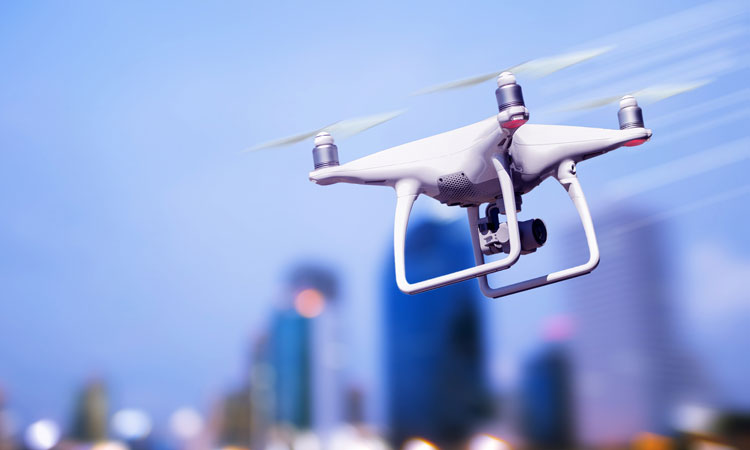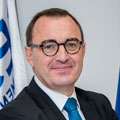SESAR: Digitalising and decarbonising Europe’s airspace
- Like
- Digg
- Del
- Tumblr
- VKontakte
- Buffer
- Love This
- Odnoklassniki
- Meneame
- Blogger
- Amazon
- Yahoo Mail
- Gmail
- AOL
- Newsvine
- HackerNews
- Evernote
- MySpace
- Mail.ru
- Viadeo
- Line
- Comments
- Yummly
- SMS
- Viber
- Telegram
- Subscribe
- Skype
- Facebook Messenger
- Kakao
- LiveJournal
- Yammer
- Edgar
- Fintel
- Mix
- Instapaper
- Copy Link
Posted: 15 June 2020 | Leah Hockley (International Airport Review), Nicolas Warinsko - SESAR | No comments yet
Leah Hockley, International Airport Review’s Junior Editor, spoke to Nicolas Warinsko, SESAR Deployment Manager’s General Manager, regarding SESAR’s goal to digitalise the European airspace.


SDM and the European aviation industry
The SESAR Deployment Manager (SDM) is a function that works to synchronise and coordinate the deployment of Common Projects, which are Commission Implementing Regulations that mandate the implementation of the most essential operational changes in the European air traffic management (ATM) master plan by the member states of the European Union (EU) and their operational stakeholders. The first Common Project is known as the Pilot Common Project (PCP) and is defined by the Regulation (EU) N°716/2014. The SDM function is performed by an aviation industry alliance composed of the leading European airlines, airports and air navigation service providers. In short, SDM is industry for industry and is coordinating the deployment of SESAR ATM modernisation in Europe.
Digitalisation is full data services everywhere in Europe, for every flight
Nicolas Warinsko, SESAR Deployment Manager General Manager, explained further: “If we take SESAR at large – definition, research and development and, eventually, deployment of projects – all of this is about modernising the European ATM system as part of the wider Single European Sky initiative of the EU. SDM is one of the main contributors to the high-level goals of this policy and, even more these days, to the environmental performance of aviation.”
A Single European Sky
The EU’s Single European Sky policy is a continent‑wide initiative that is working to improve how Europe’s airspace is managed, with the purpose of modernising Europe’s airspace structure and ATM technologies. By achieving this, the policy aims to ensure that the estimated future growth of air traffic demand can be met, safely and sustainably, whilst reducing costs, improving the industry’s environmental performance and, subsequently, ensuring that Europe’s aviation industry remains globally competitive.
The first ideas surrounding the Single European Sky initiative originated in the 1990s, before becoming official policy in 2004. The initiative represents one of the first instances in which the EU became involved with ATM.


Drones will undoubtedly play a big role in the modern airspace
European ATM suffered from major disruptions in the late 90s, as well as experiencing a significant increase in passenger demand. As a result, there was “a need for a full European holistic approach, bringing together technology, regulation, economics and legal, producing a very rich policy,” said Warinsko. When addressing the progress of the initiative, he continued: “Today, part of it is implemented. Certainly, the technological pillar is still to be completed. Not that it is running particularly late, but it was and is a major pillar, so a lot of things need to be done. Currently, already 72 per cent of the PCP is completed or being completed.”
Though technology plays a key role within the initiative, and is the central focal point for SESAR, Warinsko highlighted the importance of human factors when considering the Single European Sky. He explained: “What is important to keep in mind is that the human factor is the centre of it. It is important to keep that in mind because, when we think of technology, sometimes we could be tempted to put people and technology in competition. But this is not the case here. Really, the idea is to bring better technology into operation in order to better serve the people involved, enabling them to make more educated and safer decisions and have, in the end, more efficient air traffic whilst increasing safety levels and gaining environmental benefits for European passengers and citizens.”
Digitalising air traffic management
The modernisation of Europe’s ATM networks is crucial for the sustainability of European aviation and the forecasted increase in air traffic by 2035. In order to achieve this modernisation, digitalisation plays a key role in the development of ATM.
When asked about the importance of digitalising ATM, Warinsko said: “There are many reasons why you would want to digitalise ATM. The first of them, I believe, is to be able to constantly monitor the situation and share information, increasing the overall performance of the network and efficiency. Digitalisation – in particular, what I call the ‘step zero’ of digitalisation – is full data services everywhere in Europe, for every flight.
The idea is to bring better technology into operation in order to better serve the people involved
“We are not yet there. There are some delays in some states. There are also little delays in the fleet our stakeholders equip, but we are moving forward with a good chance of success. Of course, now, this must be caveated by the hard impact of the current COVID-19 crisis and may be subject to a bit more delay,” he added. “From there, we can then imagine further steps for the digitalisation of aviation. In particular, in changing the old way of sharing data throughout all the actors of aviation in order to implement cooperative decision making, which enables any actor to make the optimum choice for the best overall performance.”
Warinsko highlighted how the creation and introduction of new technologies – many of which are satellite-based and utilised for direct communication, delegation and surveillance – is encouraging the development and digitalisation of ATM across Europe. As a result, he stressed that there needs to be “some sort of rationalisation between legacy technological infrastructure and the new developments to come. For communication, navigation and surveillance, in particular, it tends to be national and not optimised at a European level. Of course, for the time being, new technologies have been always envisaged as an additional layer to the legacy technological infrastructure”.


Warinsko stated: “There are many reasons why you would want to digitalise ATM”
He explained further: “There is a need to go beyond that: First, to have a full European level approach to the technological infrastructure for ATM communication, navigation and surveillance; and, secondly, to decommission legacy technological infrastructure – maybe not all of it, because safety should always be the first priority, and we need to really test the new technologies to ensure that they are safe and can bring the added performance value expected. So, certainly, some parts of legacy technological infrastructures remain needed, at least for some time, but certainly not all.”
In addition to new technologies, which are being developed and improved upon endlessly, Warinsko drew attention to how physical aircraft is developing, particularly with the introduction of unmanned aircraft, such as drones. As new aircraft are developed, it makes sense that new technologies accommodate and work alongside them to develop in tandem, which is the same in reverse.
“I think digitalisation is even more required by the new types of flying objects that we will have to manage, together with passenger and freight traffic,” said Warinsko. “Certainly, the volume and diversity of this type of new traffic requires digitalisation in order to use artificial intelligence (AI) and, therefore, I would say, fully lever all of the benefits and all of the capabilities of these new types of flying objects. Of course, I refer to drones in particular.”
Decarbonising European aviation
On 11 December 2019, the President of the European Commission (EC), Ursula von der Leyen, presented the European Green Deal – a roadmap for making the EU’s economy sustainable by turning climate and environmental challenges into opportunities across all policy areas and making the transition just and inclusive for all. This included the political ambition of being the world’s first climate neutral continent by 2050.
Following the announcement, airports and aviation stakeholders across Europe began to announce their commitment to climate neutrality, setting targets for achieving carbon neutral or net‑zero carbon emissions by 2050, if not sooner. SDM is supporting the European Green Deal by modernising ATM and improving air mobility in a sustainable way.
“These days, particularly with the European Green Deal, we are all very much about decarbonisation. In fact, to be fair to SESAR, environment was one of the first high-level goals, with the main objective to reduce the emissions from aviation. Of course, the goal is still there, more and more. As far as our contribution to environmental performance is concerned, on the basis of the 150 projects completed today, our implementation enables a saving of 79,000 tonnes of CO2,” highlighted Warinsko.
He added: “When we accumulate the impact of these projects until 2030, we will have saved 1.1 million tonnes of CO2. Again, this is only for the 150 projects that have been completed. We still have 195 ongoing projects, which will bring even more benefits.”
However, Warinsko drew attention to the impact that COVID-19 is currently having on the industry, with many of Europe’s airlines grounding the majority, if not the entirety, of their aircraft fleets and airports closing sections of their infrastructure in order to limit the financial impact of the virus. “Now, I want to caveat this figure, because the figures I’m giving you have been calculated prior to the current crisis, with some project assumptions. Of course, if we have less aircraft flying, the impact of our deployment is less, so certainly these figures will have to be revised,” he explained.
Looking to the future
When asked about what the future holds for SDM, Warinsko highlighted the uncertainty currently surrounding aviation as a result of the COVID-19 pandemic, displaying how unprecedented the impact of the virus has been on all facets of the industry.
“Weeks ago, that would have been very easy to answer because, for me, the line was clear. We had a clear regulatory framework, we had clear, reasonable mandates and clear objectives,” said Warinsko. “But, now, it is far more difficult to answer this question because, frankly, we are in the middle of a crisis like we have never seen before. I think we can say that, post-crisis, nothing will be the same.”
Warinsko continued: “I cannot pretend that, on my own, I can establish the priority for the post‑crisis period. At least, I would say, an additional goal is – surely for us, maybe for all – to rethink the whole of the deployment manager, taking on board another mandatory role, which is to increase our support to our partners and members, in terms of technological knowhow, but also in terms of being an intermediate between the industry and the institutions. In particular, how institutions can help, from a financial and regulatory perspective, in the recovery from the crisis.”
In order to successfully recover from the impact of the pandemic, Warinsko stressed the importance of “the industry being willing to invest in order to ensure better performance in the future and improve the speed of cooperation, post-crisis”. He addressed the difficulties surrounding both of these aspects – currently, stakeholders are understandably more reluctant to invest and are solely focused on their own assets during such an uncertain time – but said that the aviation industry has faced many crises and has always proven to be resilient. SDM has high hopes that stakeholders will continue to work together to ensure that “when we are post‑crisis, we are still together and, together, we will recover. I want to conclude by stressing that the SDM will do everything within its mandated power to support its stakeholders”.
Biography


Biography


Issue
Related topics
Air traffic control/management (ATC/ATM), Drones, Regulation and Legislation, Safety


















